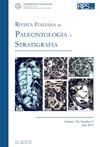论青花菜的有效性
IF 1.9
3区 地球科学
Q2 GEOLOGY
引用次数: 0
摘要
在这里,我们的目的是修复一些命名问题有关的定义有源蝶。1616年,法比奥·科隆纳首先在意大利描述了两种不同的腕足动物标本,后来被归为Terebratula属。1758年,林奈参照科隆纳的图纸,建立了《动物反常》。他描述了左上角的高度重复的标本(标本编号4),但把标本当作图中数字1(右上方)来称呼。后来有几位作者无意中犯了林奈的错误。由Lee和Brunton在1998年指出的T. terebratula的新类型指的是Colonna图中的1号标本(右上方的那个)。科隆纳的两个标本最初被认为是同义词。然而,最初由Colonna发现的4号重复标本指的是一种独特的中新世Terebratula物种,它通常被称为Terebratula sinuosa。我们回顾了支持这种命名的证据,并提供了地层学和形态学证据,证明T. sinuosa值得拥有完整的物种等级。鉴于文献中该名称的悠久传统,应保留T. sinuosa名称,因此应修改T. terebratula的定义。本文章由计算机程序翻译,如有差异,请以英文原文为准。
ON THE VALIDITY OF TEREBRATULA SINUOSA (BROCCHI)
Here we aim to fix some nomenclatural problems relating to the definition of Terebratula sinuosa. In 1616 Fabio Colonna first described two different brachiopod specimens from Italy which were later attributed to the genus Terebratula. In 1758 Linnaeus erected Anomia terebratula in reference to the drawings of Colonna. He described the heavily sulciplicate specimen figured on the upper left (specimen number 4) but addressed the specimen as if it was the number 1 in the figure (upper right). Several authors later inadvertently followed the error of Linnaeus. The neotype for T. terebratula, indicated in 1998 by Lee & Brunton, refers to the specimen number 1 in Colonna’s figure (the one to the upper right). The two specimens in Colonna were originally considered synonyms. However, the sulciplicate specimen number 4, originally figured by Colonna, refers to a distinctive Miocene Terebratula species, which has been often referred to as Terebratula sinuosa. We review evidence in favour of such a designation and provide stratigraphic and morphological evidence that T. sinuosa deserves the full rank of species. The name T. sinuosa should be maintained given the long tradition of the name in the literature, and the definition of T. terebratula should therefore be amended.
求助全文
通过发布文献求助,成功后即可免费获取论文全文。
去求助
来源期刊
CiteScore
3.60
自引率
4.30%
发文量
28
审稿时长
>12 weeks
期刊介绍:
The Rivista Italiana di Paleontologia e Stratigrafia was founded in 1895. It publishes original papers dealing with all fields of paleontology and of stratigraphy, from Italy and the Mediterranean to the Tethys, as well across the globe from China to North America.

 求助内容:
求助内容: 应助结果提醒方式:
应助结果提醒方式:


